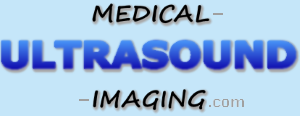Medical Ultrasound Imaging
Friday, 16 May 2025
Ultrasound Database •
Acoustic mismatch arise at the boundary between two different media where reflection and refraction occur. See also Snells Law. •
The acoustic power of sound and ultrasound is the energy delivered per unit of time. The power is measured in Watt (W) and is proportional to the square of the amplitude. 1 W = 1 joule/second. See also Directivity Index, Spatial Average Intensity, and Source Level. • View NEWS results for 'Acoustic Power' (1). •
Through diffraction and refraction on intersections edge acoustic shadowing can be created. The acoustic shadowing artifact is the loss of information below a dense object because the majority of the sound energy was reflected back by the object.
Shadowing artifacts occur if decreasing of the echo amplitude is not exponential with penetration depth caused by inhomogeneous tissue layers and fluid or air-filled regions. Bone, air, foreign bodies and calcification stop the transmission of sound waves producing a 'sonic shadow' which is a dark region distal to the echogenic obstructing region. This artifact occurs also in objects like e.g. prosthetic valves. See also Boundary Layer, and Half-Value Layer. Further Reading: News & More:
•
The acoustic window or field is the area defined by the pathway of the ultrasound beam between the transducer and the acoustic reflector. The sound reflection to skin boundary should be minimized with an ultrasound gel where this gel acts as an acoustic window through which the image is seen. Acoustic window refers also to the optimal placing of the transducers so that the areas of interest are clearly imaged. See also Transforaminal Window, Transcranial Window, Transorbital Window and Transtemporal Window. •
(AALs) Acoustically active lipospheres and ultrasound are under development to deliver bioactive molecules to the vascular endothelium. The AALs are similar to both ultrasound contrast agents and drug-delivering liposomes. They can carry bioactive substances using biologically inert shells and deliver those substances when disrupted by ultrasound. The lipospheres consist of a small gas microbubble surrounded by a thick oil shell and are enclosed by an outermost lipid layer. The gas bubble contained in these vehicles makes them acoustically active, similar to ultrasound contrast agents. Acoustically active lipospheres can be nondestructively deflected using ultrasound radiation force, and fragmented with high intensity ultrasound pulses. Their lipid-oil complex can carry bioactive substances at high concentrations. An optimized sequence of ultrasound pulses can deflect the AALs toward a vessel wall then disrupt them, painting their contents across the vascular endothelium. See also Filling Gas, and MRX 115. Further Reading: Basics:
News & More:
|
Medical-Ultrasound-Imaging.com
former US-TIP.com
Member of SoftWays' Medical Imaging Group - MR-TIP • Radiology TIP • Medical-Ultrasound-Imaging
Copyright © 2008 - 2025 SoftWays. All rights reserved.
Terms of Use | Privacy Policy | Advertise With Us
former US-TIP.com
Member of SoftWays' Medical Imaging Group - MR-TIP • Radiology TIP • Medical-Ultrasound-Imaging
Copyright © 2008 - 2025 SoftWays. All rights reserved.
Terms of Use | Privacy Policy | Advertise With Us
[last update: 2025-04-05 02:38:00]




